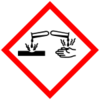5.6 Corrosives
Chlorosulfonic acid, fuming sulfuric acid, concentrated sulphuric acid, concentrated nitric acid, concentrated hydrochloric acid, hydrofluoric acid, strong alkalis, and bromine, etc. should be handled with the greatest care. Remember that perchloric acid is explosive when it comes in contact with organic materials. Such chemicals should not be stored on high shelves, nor transported or stored permanently in beakers or flasks.
Bottles containing such chemicals are best transported in plastic buckets or similar containers. Glass vessels that contain bromine can become brittle and should therefore be handled especially carefully. When working with corrosive chemicals, protective goggles should be worn. When handling large amounts of corrosive substances or when tapping from large bottles or diluting acids or alkalis, protection for the entire face should be used.
The alkali metals (primarily lithium, sodium, and potassium) should be stored in paraffin or kerosene. Protective gloves should always be worn when working with alkali metals.
Note that acids that produce corrosive gases/fumes e.g. perchloric acid, aqua regia and concentrated hydrochloric acid must only be handled in special, flushable fume hoods. These fume hoods are available in building 5, floor -1, room 074A. Contact the Environmental Health & Safety (EHS) Coordinator, e-mail: johan.tejler@kc.lu.se for access and information.
Corrosive hazards are indicated under GHS (Globally Harmonized System of Classification and Labelling of Chemicals) by the corrosion pictogram.

Corrosive material should be marked with this pictogram.

Cupboards containing corrosives should be marked with this pictogram.
